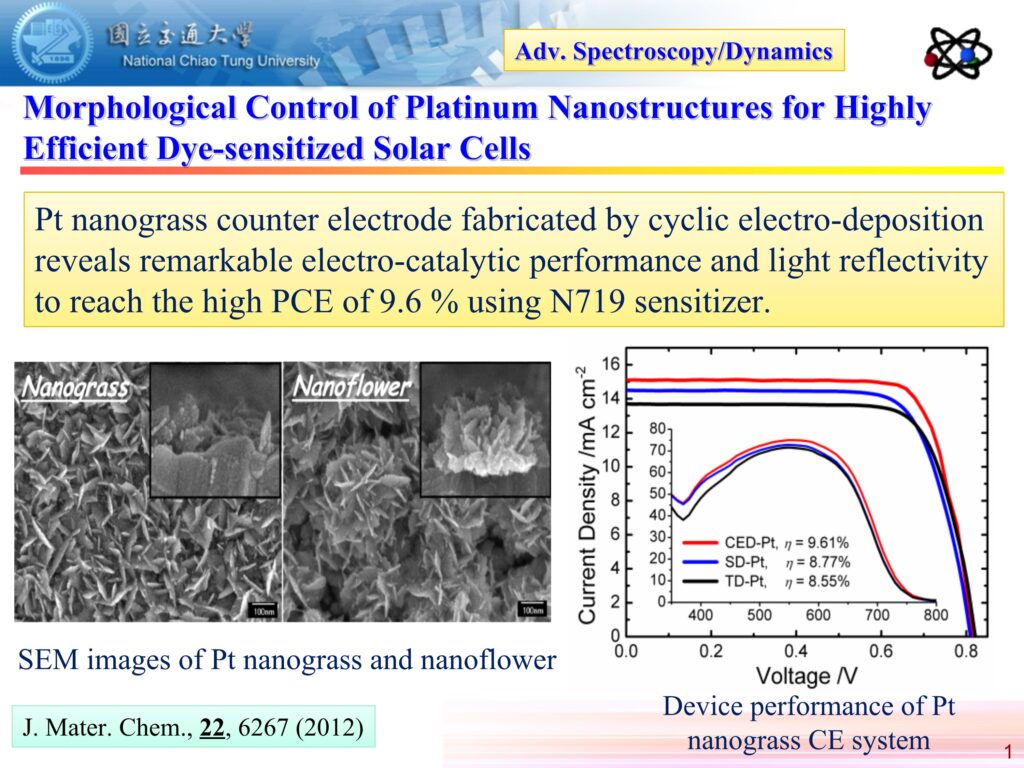

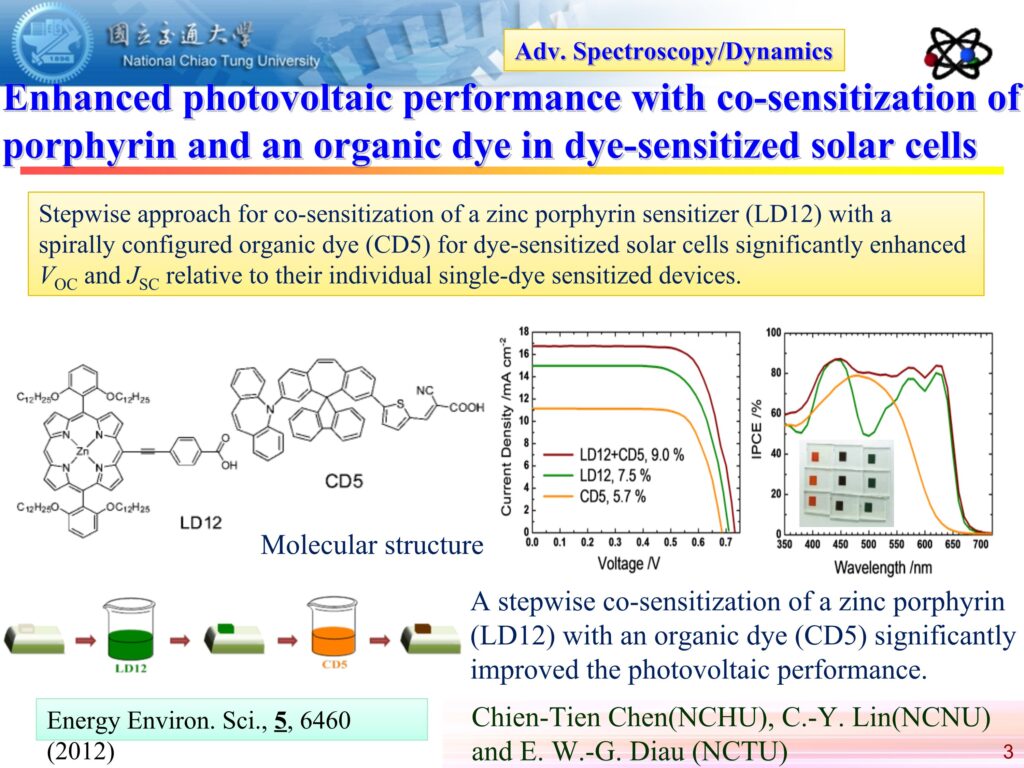
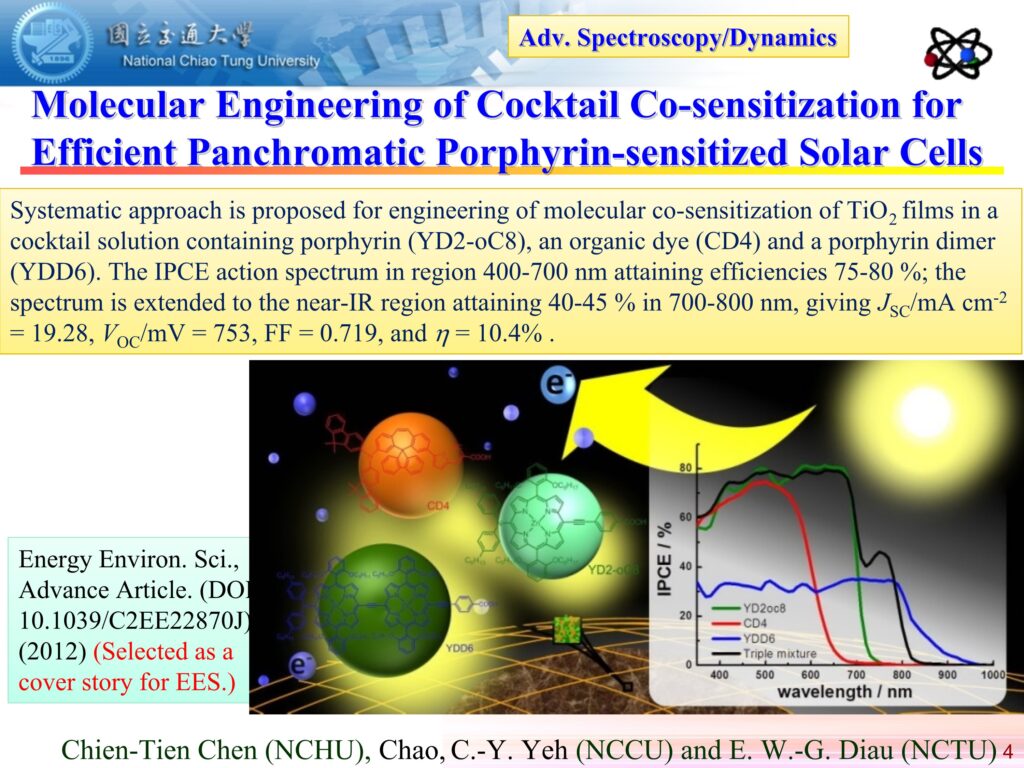
Morphological Control of Platinum Nanostructures for Highly Efficient Dye-sensitized Solar Cells
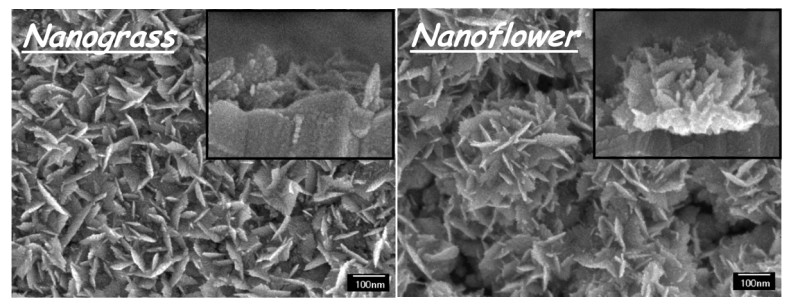
Cyclic electro-deposition (CED) is a cost-effective tool to synthesize nanostructures with a solution process, controllable morphology and high purity. Here we report novel platinum nanostructures fabricated according to CED at room temperature in solution containing H2PtCl6 precursor and NaNO3. Remarkable Pt nanostructures, from nanocluster, nanosheet, nanograss to nanoflower, were produced through morphological control via variation of either period of CED scans or concentration of the precursor. Pt films with uniform nanograss structure have great electro-catalytic performance and intrinsic light-scattering, perfectly suitable for use as counter electrodes for dye-sensitized solar cell (DSSC). The corresponding DSSC device attained efficiency 9.61 %, which is 12 % enhanced from that fabricated according to a conventional method via thermal decomposition under similar experimental conditions.
* L.-L. Li, C.-W. Chang, H.-H. Wu, J.-W. Shiu, P.-T. Wu, E. W.-G. Diau, “Morphological control of platinum nanostructures for highly efficient dye-sensitized solar cells”, J. Mater. Chem. 22, 6267 (2012).
Design and Characterization of Heteroleptic Ruthenium Complexes Containing Benzimidazole Ligands for Dye-sensitized Solar Cells: The Effect of Fluorine Substituents on Photovoltaic Performance

Heteroleptic ruthenium complexes (RD12-RD15) containing fluoro-substituted benzimidazole ligands were designed, synthesized and characterized for dye-sensitized solar cells. The resulting devices show a systematic trend of increasing VOC and decreasing JSC with fluorine atoms of increasing number substituted on the ligand. Results of femtosecond infrared transient absorption spectroscopy, charge extraction and the intensity-modulated photovoltage spectra are consistent with the variation of VOC for the systems. The best device (RD12) attained an efficiency 9.6 % of power conversion, superior to that of N719 (h = 9.3 %) under the same experimental conditions.
* W.-K. Huang, H.-P. Wu, P.-L. Lin, Y.-P. Lee, E. W.-G. Diau, “Design and Characterization of Heteroleptic Ruthenium Complexes Containing Benzimidazole Ligands for Dye-sensitized Solar Cells:. The Effect of Fluorine Substituents on Photovoltaic Performance”, J. Phys. Chem. Lett. 3, 1830 (2012).
Enhanced photovoltaic performance with co-sensitization of porphyrin and an organic dye in dye-sensitized solar cells
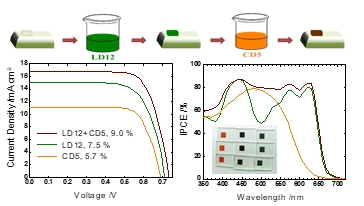
A stepwise approach for co-sensitization of a zinc porphyrin sensitizer (LD12) with a spirally configured organic dye (CD5) for dye-sensitized solar cells significantly enhanced VOC and JSC relative to their individual single-dye sensitized devices. upon optimization, the device made of the LD12+CD5 system yielded JSC/mA cm-2 = 16.7, VOC/V = 0.74, FF = 0.73 and h = 9.0 %, which is superior to that of either individual device made from LD12(h = 7.5 %) and CD5 (h = 5.7 %) under the same conditions of fabrication. The photocurrent density JSC is enhanced because of the combined light-harvesting effect of the two dyes that have complementary absorption spectra, and the photovoltage VOC is enhanced because the retarded charge recombination overwhelmed the shift down of the TiO2 potential.
* C.-M. Lan, H.-P. Wu, T.-Y. Pan, C.-W. Chang, W.-S. Chao, C.-T. Chen, C.-L. Wang, C.-Y. Lin and E. W.-G. Diau, “Enhanced photovoltaic performance with co-sensitization of porphyrin and an organic dye in dye-sensitized solar cells”, Energy Environ. Sci. 5, 56460-6464 (2012).
Molecular Engineering of Cocktail Co-sensitization for Efficient Panchromatic Porphyrin-sensitized Solar Cells
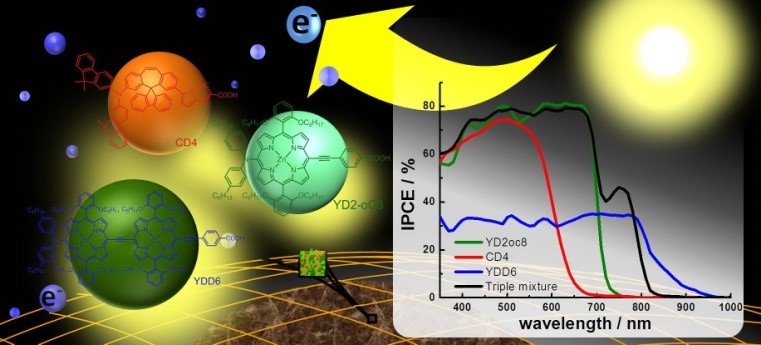
Co-sensitization of three spectrally complementary dyes (YD2-oC8, YDD6 and CD4) on TiO2 film in a well-designed cocktail solution significantly improved the photovoltaic performance of the device. A systematic approach is proposed for engineering of molecular co-sensitization of TiO2 films in a cocktail solution containing a push-pull zinc porphyrin (YD2-oC8), an organic dye (CD4) and a porphyrin dimer (YDD6) in a specific molar ratio to optimize the photovoltaic performance of the device. The resulting device showed panchromatic spectral features in the IPCE action spectrum in region 400-700 nm attaining efficiencies 75-80 %; the spectrum is extended to the near-IR region attaining 40-45 % in 700-800 nm, giving JSC/mA cm-2 = 19.28, VOC/mV = 753, FF = 0.719, and = 10.4 %, which is superior to the single-dye (YD2-oC8, h = 8.8 %) or the two-dye (YD2-oC8+CD4, = 9.2 %) co-sensitized system.
* H.-P. Wu,Z.-W. Ou, T.-Y. Pan, C.-M. Lan, W.-K. Huang, H.-W. Lee,N. M. Reddy, C.-T. Chen, W.-S. Chao,C.-Y. Yeh and E. W.-G. Diau, “Molecular Engineering of Cocktail Co-sensitization for Efficient Panchromatic Porphyrin-sensitized Solar Cells”, Energy Environ. Sci.,Advance Article(DOI: 10.1039/C2EE22870J) (2012).